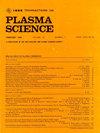s波段烤箱磁控管注入锁定的超低能量模拟
IF 1.3
4区 物理与天体物理
Q3 PHYSICS, FLUIDS & PLASMAS
引用次数: 0
摘要
提出了一种用于s波段微波炉的新型同轴线注入锁磁控管结构,并进行了仿真分析。磁控管是一种高效的正交场振荡器,其谐振腔壁上直接开有注入口。它通过同轴线将一定数量的功率耦合到交互空间中。喷射功率设置为32w。在磁控管启动阶段,由于注入的小信号的影响,电子流发生了预调制。当注入时间为20ns时,最大锁定范围为3mhz。外部注入信号成功锁定磁控管输出信号。新结构与短时间注入方法相结合,实现了超低能量注入锁紧效果。与传统磁控管的10ms脉冲时间相比,该方法的锁定能量仅为0.02。当注入功率设置为200w时,锁定范围扩展到8mhz。在锁定状态下,改变注入信号的初始相位不影响输出信号与注入信号之间的相位差。在相同频率下,相位差几乎保持不变。这为将来通过单通道注入控制多磁控管阵列的频率和相位提供了可能。该注入方法可以满足炉用磁控管的阵列应用要求。本文章由计算机程序翻译,如有差异,请以英文原文为准。
Particle-in-Cell Simulations of Injection Locking for S-Band Oven Magnetron Using Ultralow Energy
A novel coaxial-line injection-locked magnetron structure for an S-band microwave oven has been proposed, and simulation analysis has been conducted. The magnetron is regarded as a highly efficient orthogonal-field oscillator, with an injection port directly opened on the wall of its resonant cavity. It is coupling a certain amount of power into the interaction space through a coaxial line. The injection power is set at 32 W. During the start-up phase of the magnetron, the electron flow undergoes pre-modulation due to the influence of the injected small signal. When the injection duration is 20 ns, the maximum locking range is 3 MHz. The magnetron’s output signal is successfully locked by the external injection signal. The new structure combined with the short-time injection method achieves an ultralow energy injection-locking effect. Compared with the 10-ms pulse time of the traditional magnetron, the locking energy of this method is only 0.02. When the injection power is set to 200 W, the locking range extends to 8 MHz. In the locked state, changing the initial phase of the injected signal does not affect the phase difference between the output signal and the injected signal. The phase difference remains almost unchanged at the same frequency. This provides the possibility of controlling the frequency and phase of multiple magnetron arrays through single-channel injection in the future. This injection method can meet the array application requirements of magnetrons for ovens.
求助全文
通过发布文献求助,成功后即可免费获取论文全文。
去求助
来源期刊

IEEE Transactions on Plasma Science
物理-物理:流体与等离子体
CiteScore
3.00
自引率
20.00%
发文量
538
审稿时长
3.8 months
期刊介绍:
The scope covers all aspects of the theory and application of plasma science. It includes the following areas: magnetohydrodynamics; thermionics and plasma diodes; basic plasma phenomena; gaseous electronics; microwave/plasma interaction; electron, ion, and plasma sources; space plasmas; intense electron and ion beams; laser-plasma interactions; plasma diagnostics; plasma chemistry and processing; solid-state plasmas; plasma heating; plasma for controlled fusion research; high energy density plasmas; industrial/commercial applications of plasma physics; plasma waves and instabilities; and high power microwave and submillimeter wave generation.
 求助内容:
求助内容: 应助结果提醒方式:
应助结果提醒方式:


